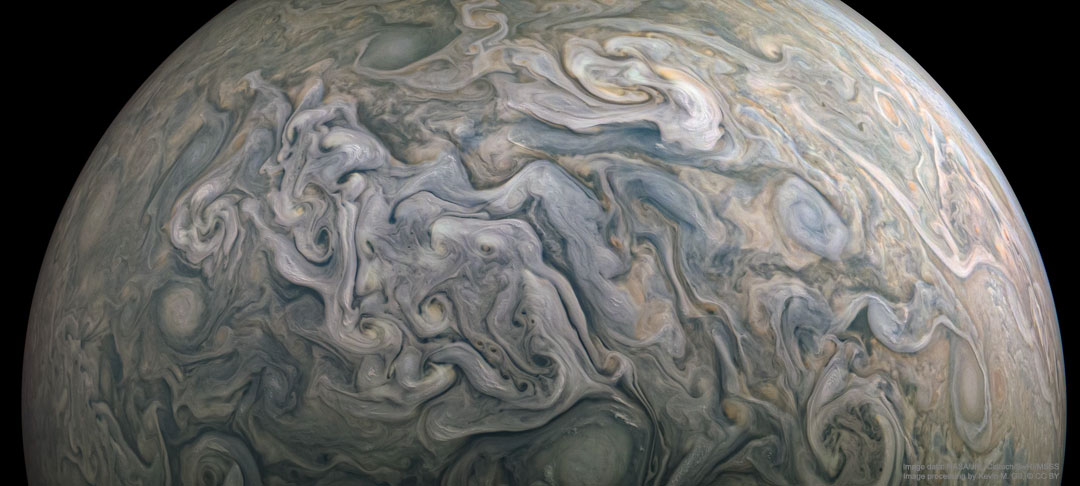木星湍动的云
2020年8月11日
Churning Clouds on Jupiter
Image Credit & License: NASA/JPL-Caltech/SwRI/MSSS; Processing: Kevin M. Gill
Explanation: Where is Jupiter’s ammonia? Gaseous ammonia was expected to be seen in Jupiter’s upper atmosphere by the orbiting Juno spacecraft — but in many clouds is almost absent. Recent Juno data, however, gives some clues: some high-level clouds appear to be home to an unexpected type of electrical discharge dubbed shallow lightning. Great charge separations are needed for lightning, which might be created by colliding mushballs lifted by rising updrafts of gas. Ammonia and water stick to these mushballs which rise until they get too heavy — after which they fall deep into Jupiter’s atmosphere and melt. By this process, ammonia found missing from Jupiter’s upper atmosphere reappears below. Pictured by Juno, churning clouds on Jupiter show not only mesmerizing complexity but some high-level, light-colored pop-up clouds. Understanding atmospheric dynamics on Jupiter gives valuable perspective to similar atmospheric and lightning phenomena that occur on our home Earth.
Peaking Tonight: The Perseid Meteor Shower
Tomorrow’s picture: Comet NEOWISE’s Pointing Tail
木星湍动的云
影像提供与授权: NASA/JPL-Caltech/SwRI/MSSS; 影像处理: Kevin M. Gill
说明: 木星的氨到那里去了?正在绕行木星的朱诺号太空船,预期会在木星的高层大气看到大量的氨气,然而许多木星云却几乎不含氨。朱诺号最新的量测数据给出了部分线索:一些高云内,有名为浅层闪电的特殊放电事件现象。要产生闪电得先造成大规模的电荷分离,而产生电荷分离的媒介,或许是抬升气流内互撞的含氨冰雹。在抬升气流内,氨和水不停凝结附着在涌升的含氨冰雹上,直到它们变得太重无法再上升,接着就下坠深入木星大气并溶解于其中。经由这种过程,木星高层大气中失踪的氨在下层大气中复现。在这幅由朱诺号拍摄的影像里,木星湍动的云之复杂度不仅让人看得目眩神迷,而且有些还镶着淡色高突的云顶。了解木星的大气动力学,让我们能以不同的视角来看地球上类似的大气和闪电现象。 (mushballs 含氨冰雹)
今晚达到顶峰:英仙座流星雨


有水?